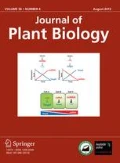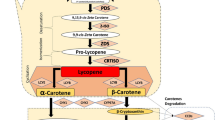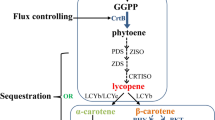Abstract
Carotenoids are not naturally accumulated in the endosperms of rice, which is a cereal crop. In our previous study, biofortified rice seeds accumulated two red color carotenoids, ketocarotenoids including astaxanthin and ketoxanthophylls including capsanthin, via four-step pathway engineering. Their biosynthetic pathways require zeaxanthin as a common precursor and then bifurcated. In this study, cross-fertilization between two astaxanthin (BP and sBP) and two capsanthin (C and CB) rice plants were reciprocally performed to elucidate the rice seed system’s metabolic preference. Filial seeds showed different colors in red hues between mutually interbred lines as well as from parents. The strongest driving force for metabolism was caused by the sBP line for astaxanthin regardless of the parent side and proved to be the most efficacious customized synthetic gene for rice crops. It further resulted in the highest astaxanthin levels when paternal sBP mated with maternal CB line, which has the biggest capacity of total carotenoids. Also, reciprocal crosses between CB and BP lines ascertained their metabolically balanced gene efficacy by showing the pathway preference toward either ketoxanthophylls or ketocarotenoids depending on the paternal parental side. Our study suggests that gene efficacy plays the most decisive role in leading the metabolic path and revealed the unexpectedly paternal parent-of-origin effects in the endosperm. Consequently, we simultaneously biofortified rice crops with two functional red carotenoids and finally generated new red-colored rice varieties.




Similar content being viewed by others
References
Bleckmann A, Alter S, Dresselhaus T (2014) The beginning of a seed: regulatory mechanisms of double fertilization. Front Plant Sci 5:452
Bunea A, Socaciu C, Pintea A (2014) Xanthophyll esters in fruits and vegetables. Not Bot Horti Agrobo 42(2):310
Chandran AKN, Hong W-J, Abhijith B, Lee J, Kim Y-J, Park SK, Jung K-H (2020) Rice Male Gamete Expression Database (RMEDB): a web resource for functional genomic studies of rice male organ development. J Plant Biol 63(6): 421–430
Enfissi EMA, Nogueira M, D’Ambrosio C, Stigliani AL, Giorio G, Misawa N, Fraser PD (2019) The road to astaxanthin production in tomato fruit reveals plastid and metabolic adaptation resulting in an unintended high lycopene genotype with delayed over-ripening properties. Plant Biotechnol J 17:1501–1513
Fang N, Wang C, Liu X, Zhao X, Liu Y, Liu X, Du Y, Zhang Z, Zhang H (2019) De novo synthesis of astaxanthin: from organisms to genes. Trends Food Sci Technol 92:162–171
Fernández-García E, Carvajal-Lérida I, Jarén-Galán M, Garrido-Fernández J, Pérez-Gálvez A, Hornero-Méndez D (2012) Carotenoids bioavailability from foods: from plant pigments to efficient biological activities. Food Res Int 46(2):438–450
Fiedor J, Burda K (2014) Potential role of carotenoids as antioxidants in human health and disease. Nutrients 6(2):466–488
Fujisawa M, Takita E, Harada H, Sakurai N, Suzuki H, Ohyama K, Shibata D, Misawa N (2009) Pathway engineering of Brassica napus seeds using multiple key enzyme genes involved in ketocarotenoid formation. J Exp Bot 60:1319–1332
Ha S-H, Liang YS, Jung H, Ahn M-J, Suh S-C, Kweon S-J, Kim D-H, Kim Y-M, Kim J-K (2010) Application of two bicistronic systems involving 2A and IRES sequences to the biosynthesis of carotenoids in rice endosperm. Plant Biotechnol J 8(8):928–938
Ha S-H, Kim JK, Jeong YS, You MK, Lim S-H, Kim JK (2019) Stepwise pathway engineering to the biosynthesis of zeaxanthin, astaxanthin and capsanthin in rice endosperm. Metab Eng 52:178–189
Hussein G, Sankawa U, Goto H, Matsumoto K, Watanabe H (2006) Astaxanthin, a carotenoid with potential in human health and nutrition. J Nat Prod 69(3):443–449
Industry Experts (2018) Global astaxanthin market: sources, technologies and applications. http://industry-experts.com/verticals/healthcare-and-pharma/global-astaxanthin-market-sources-technologies-and-applications. Accessed Aug 2018
Jeknić Z, Morré JT, Jeknić S, Jevremović S, Subotić A, Chen THH (2012) Cloning and functional characterization of a gene for capsanthin-capsorubin synthase from Tiger lily (Lilium lancifolium Thunb. ‘Splendens’). Plant Cell Physiol 53(11):1899–1912
Jeong YS, Ku H-K, Kim JK, You MK, Lim S-H, Kim J-K, Ha S-H (2017) Effect of codon optimization on the enhancement of the β-carotene contents in rice endosperm. Plant Biotechnol Rep 11(3):171–179
Jeong YS, Ku H-K, Jung Y-J, Kim JK, Lee KB, Kim J-K, Lim S-H, Lee D, Ha S-H (2021) 2A-linked bi-, tri-, and quad-cistrons for the stepwise biosynthesis of β-carotene, zeaxanthin, and ketocarotenoids in rice endosperm. Metab Eng Commun 12:e00166
Ku H-K, Jeong YS, You MK, Jung Y-J, Kim TJ, Lim S-H, Kim JK, Ha S-H (2019) Alteration of carotenoid metabolic machinery by β-carotene biofortification in rice grains. J Plant Biol 62(6):451–462
Maeda H, Saito S, Nakamura N, Maoka T (2013) Paprika pigments attenuate obesity-induced inflammation in 3T3-L1 adipocytes. ISRN Inflamm 2013:763758–763759
Pierce EC, LaFayette PR, Ortega MA, Joyce BL, Kopsell DA, Parrott WA (2015) Ketocarotenoid production in soybean seeds through metabolic engineering. PLoS ONE 10(9):e0138196
Tian S, Li L, Chai W, Shah SNM, Gong Z (2014) Effects of silencing key genes in the capsanthin biosynthetic pathway on fruit color of detached pepper fruits. BMC Plant Biol 14(1):314
Vanamala J (2017) Food systems approach to cancer prevention. Crit Rev Food Sci Nutr 57(12):2573–2588
Zheng X, Giuliano G, Al-Babili S (2020) Carotenoid biofortification in crop plants: citius, altius, fortius. Biochim Biophys Acta Mol Cell Biol Lipids 1865(11):158664
Zhu C, Naqvi S, Breitenbach J, Sandmann G, Christou P, Capell T (2008) Combinatorial genetic transformation generates a library of metabolic phenotypes for the carotenoid pathway in maize. Proc Natl Acad Sci USA 105:18232–18237
Zhu Q, Zeng D, Yu S, Cui C, Li J, Li H, Chen J, Zhang R, Zhao X, Chen L, Liu Y (2018) From Golden Rice to aSTARice: bioengineering astaxanthin biosynthesis in rice endosperm. Mol Plant 11(12):1440–1448
Acknowledgements
This work was supported by the BioGreen21 Agri-Tech Innovation Program (PJ01567101 to S.-H. Ha) and the Next Generation New Plant Breed Technology Program (PJ01477202 to S.-H. Ha), funded by the Rural Development Administration, Republic of Korea.
Author information
Authors and Affiliations
Corresponding author
Ethics declarations
Conflict of Interest
The authors have no competing interests to declare.
Ethical Approval
Not applicable.
Supplementary Information
Below is the link to the electronic supplementary material.
Rights and permissions
About this article
Cite this article
Jeong, Y.S., Kim, J.K., Baek, SA. et al. Reciprocal Crosses Between Astaxanthin and Capsanthin Rice Unravel Effects of Metabolic Gene Efficacy in Rice Endosperm. J. Plant Biol. 64, 371–377 (2021). https://doi.org/10.1007/s12374-021-09317-2
Received:
Revised:
Accepted:
Published:
Issue Date:
DOI: https://doi.org/10.1007/s12374-021-09317-2




